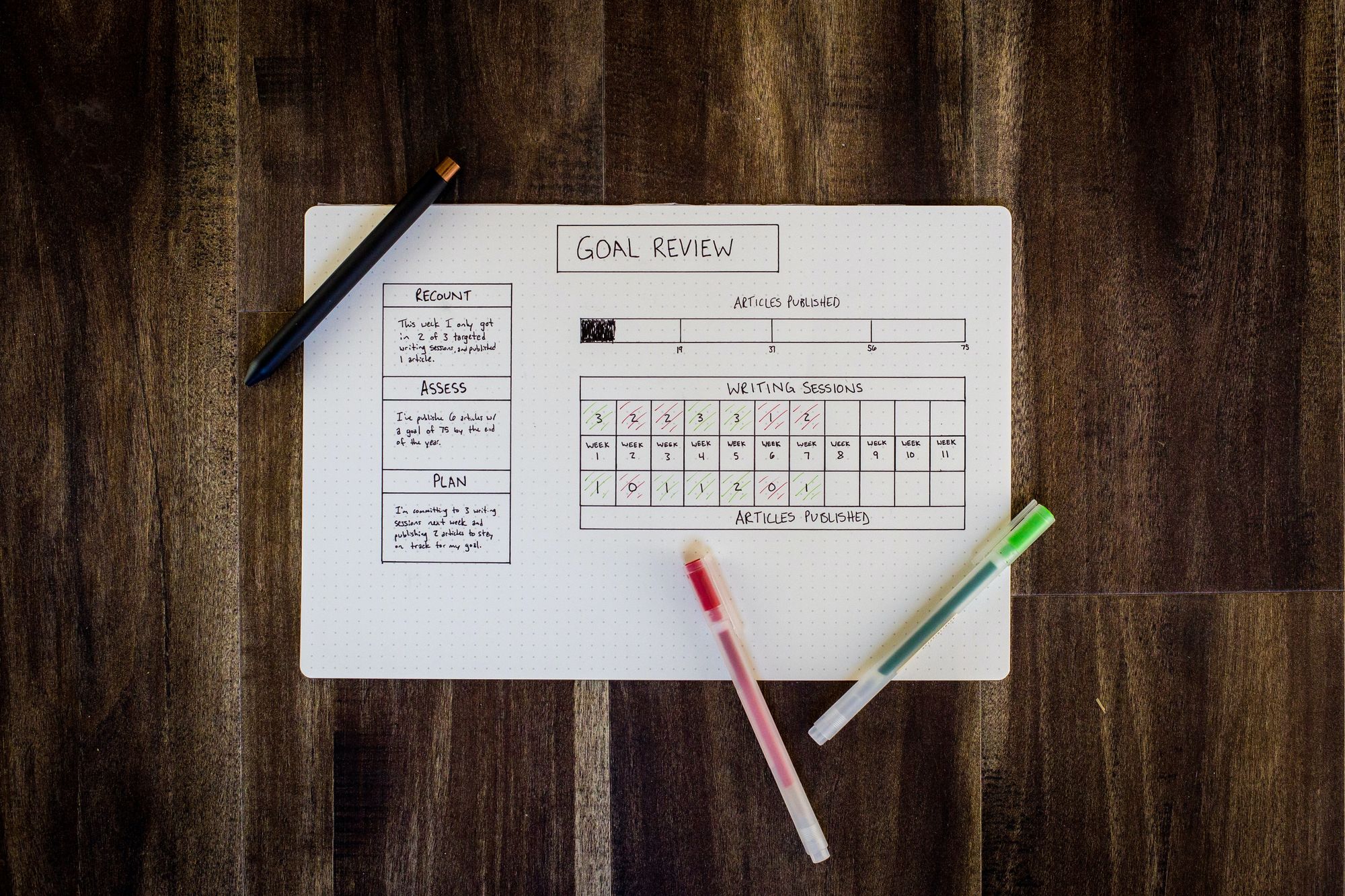The Ultimate Guide to Prioritization, Part 2: How To Decide What To Do... And Do It!
Once you know what NOT to do, you can prioritize what's left. Learn 5 ways to prioritize what’s important and get it done!

In The Ultimate Guide to Prioritization, Part 1: How to Decide What NOT To Do (When Everything Feels Important), I covered how to review your IMPOSSIBLY LONG task list through the lens of what NOT to do, to help narrow it down.
Once you have the list of things you have to do, you then prioritize that list, which is more manageable and less overwhelming.
So let’s do it!
5 ways to prioritize what’s important and do it
1. Connect your tasks to your goals
Most of us have goals of some kind. Personal, financial, career, family, health, fitness, business... there are things you want to achieve across the various facets of your life. Every day when you get up and start the day, you have an opportunity to move the needle towards reaching those goals.
BUT... it's easy to have your day carried away with other people's priorities and goals and have your own put on the back burner over and over.
When you decide what you are going to do each day, ask yourself:
- Does doing this get me closer to achieving my goals?
- Does this move the needle on what’s important to me?
- Is this my priority (or someone else’s)?
- Is this a procrastination activity?
Depending on the answers to these questions, it is worth taking a step back and asking yourself:
- Why am I doing it?
- What made me decide to do this instead of something else?
Note: if you don’t have any solid goals, here’s a place to start: Set Direction with Goals, Make Progress with Systems.
Of course, not everything you do will have a direct line to a goal. There are always administrative or operational tasks and activities that need to be done to keep things running smoothly. We all have to do laundry! But those types of tasks can still be planned for and grouped so they are less likely to interrupt or disrupt your days.
Also, sometimes you have to work on other people’s fires or priorities and that's ok! It's part of interacting with all the people in your life. The key is to be thoughtful and intentional about it. Make sure the tasks you choose each day, are just that, ones YOU choose... instead of letting others choose for you and that your goals are not always pushed off.

2. Review your tasks through the Urgent vs Important matrix
The Urgent vs Important matrix, also known as an Eisenhower matrix, is a model you can use with your tasks to help get clarity on how the perceived urgency of a task is interfering with getting it done.
The Urgent vs Important matrix is a lens to look at your tasks specifically to ensure you pay attention to the items that usually get neglected, but are often most valuable to you long term: the Important but not Urgent tasks.
Let’s work through the matrix as a whole:
Distractions: Neither urgent nor important
The worst of all activities are the things that don’t matter. These are the procrastination activities or small tasks you decide to do to “clear the decks” so you feel like you have done something. But you haven’t moved the needle on your goals or anything of value. These make you feel busy but are not truly productive.
When you are looking for what NOT to do or working through your 4Ds, these are the ones you delete altogether.
Interruptions: Urgent but not important
This is where we spend and waste an inordinate amount of time! These are the types of things that I reference in my series on dispelling the curse of immediacy. Email, instant messages, meetings, and texts: they are often other people’s fires and best delegated, or thoughtfully rescheduled for later times. Remember, email is the to-do list that other people add to!
Set aside a specific time and set your boundaries!
Critical activities: Urgent and important
This is where you spend most of your time. Putting out the fires!
They are deadline-driven or emergency tasks or activities at the top of your to-do list.
What you want to do is minimize the amount of time you spend focusing on these activities through planning. Time-blocking, which I cover below and in my article Time-Blocking and Imagining Your Ideal Week, is a good way to manage these.
Important goals: Important but not urgent
This is the most important section of all!
These are tasks you know you need to put time and attention into but they often get pushed off in favour of fire-fighting. They are planning and thinking-oriented tasks that lead to better overall outcomes in your life and work, but require that you give them time (without being on fire!).
These tasks might not even appear on your to-do list to begin with!
One way to make sure you actually do these important but not urgent tasks is to set aside time for them every week, month, and/or quarter. Book it in your calendar!
For example, my business partners and I have a standing meeting in the first week of each quarter to review our goals and make new ones together. Set it and keep it so you don't forget.
3. Eat the frog
When you have a large or important task on your list, sometimes it is the one you procrastinate about most.
It's that feeling when you want to make sure you have a solid block of uninterrupted time to do the thing you want… but you don’t set aside that time, get distracted by a million other little things, and never actually do it.
A great way to make sure you do, or at least make progress on it, is to do it first. This ensures all the other inevitable fires and distractions of the day don’t push it off. Your frog is that one thing.
Instead of opening up your email and signing into your chat app to be inundated with the morning's fires, eat the frog (or at least take some tiny nibbles😅) so you can keep it from hanging over you and taking up mental space.
Start every morning by asking yourself: “What frog am I going to eat today?” (Phrase compliments of author Brian Tracy.)

4. Set realistic expectations through time-blocking
Have you ever selected 5 things from your task list for the day, only gotten through 3 of them, and then felt like a failure for not getting them all done? Did you also have 3 meetings, actually fed yourself, and picked your kids up from school?
It’s possible (likely!) you didn’t set realistic expectations for what was actually possible in a given day.
A great way to avoid setting yourself up for disappointment and feeling like you didn’t get enough done (whatever enough means) is to prioritize your tasks based on your actual available time in your calendar by time blocking them.
Again, I have an entire article on time-blocking and imagining your ideal week, but the gist is that you can more realistically prioritize your tasks when you look at them in relation to your actual commitments. If you have 3 meetings scattered throughout the morning, it’s probably not a good idea to plan to work on your strategic plan.
Take your task list and look at your calendar schedule for the week. Then plan when you will ideally do each of those tasks during your current week. If it's a short, low-brain power task, plop it in the hour break you have between two meetings. If it's a big project that would benefit from some focused time, block it on your open Thursday morning.
When you are time-blocking, also consider which tasks work best during which times of the day based on your mental energy (as mentioned in the previous article). Don’t block a deep-thinking task for the last hour of a Friday! It’s probably not going to happen😁.
5. Organize your tasks using the Ivy Lee method
The Ivy Lee method is one I came across via the author James Clear (author of Atomic Habits). It’s a task organization technique that I like because it forces you to narrow your list down to six things and no more, and then work through each item to completion.
It’s based on the idea that multitasking is bad for productivity.
The process is as follows:
- At the end of each work day, write down the six most important things you need to accomplish tomorrow. Do not write down more than six tasks.
- Prioritize those six items in order of their true importance. This might be deadline-driven but also allows you to slot in the important but not urgent strategic planning activities mentioned above.
- When you arrive tomorrow, concentrate only on the first task. Work until the first task is finished before moving on to the second task.
- Approach the rest of your list in the same fashion. At the end of the day, move any unfinished items to a new list of six tasks for the following day.
- Repeat this process every working day.
The benefits of this approach are:
1. Reduces decision fatigue: You don’t have to decide at the end of each task what the next one will be. You have already decided on "the next best thing” so there are fewer decision points in a day.
2. Uni-task: You set the intention before you start that you will work on something until it is done. Ideally, this prevents you from bouncing around.
3. Reduces procrastination: If you mentally commit to working through a task until it is done, in a particular order, it’s harder to avoid a task you don’t want to do or stop working on it in favour of another. You just get it done!
While more structured than some people prefer and not always practical, it’s a good frame for rhythmically working through your task list in 6 chunks.
Prioritize you
I would be remiss not to include how important it is to make sure that you include yourself on your IMPOSSIBLY LONG task list… and not at the bottom, never to rise to the top. In truth, you need to make sure you are always near the top. I have made the case over and over that you do yourself and everyone/everything that is important to you a disservice by putting yourself last and not taking care of yourself.
When you are deciding what to say no to and what to include, make sure that part of those decisions is things that fill your bucket: self-maintenance, time with people you love, and time doing things you love. Those are the things that are so often pushed to a later time but are also the most important things to prioritize.

Now go do it, as best you can…whatever it is!
Prioritization can be tricky because it is often a moving target. If you can hold in your mind that not everything can or will be done, you can shift your thinking to what truly matters.
There are things that matter and things that don’t.
There are things that are worth giving your energy and attention to and things that aren’t. You have so much more control over what and when you do things than you think…so take that control!
Look at your IMPOSSIBLY LONG task list. Narrow it down as far as it can go. Leave space for you. And do the best you can each day.
Do you need help narrowing down your task list? I can help! Book a free consultation and we can chat about it!
Share
Ashley Janssen

Productivity consultant, writer, speaker, serial entrepreneur, chaos calmer, introvert, cat-lady. Lover of books, fitness, old fashioned’s, basketball, and video games.
Follow me on
Twitter
or
LinkedIn.
Hire me for
1 on 1 productivity consulting
or
speaking.
Related articles

When You Do Things Matters

What If Being Lazy Was a Good Thing?


Comments ()